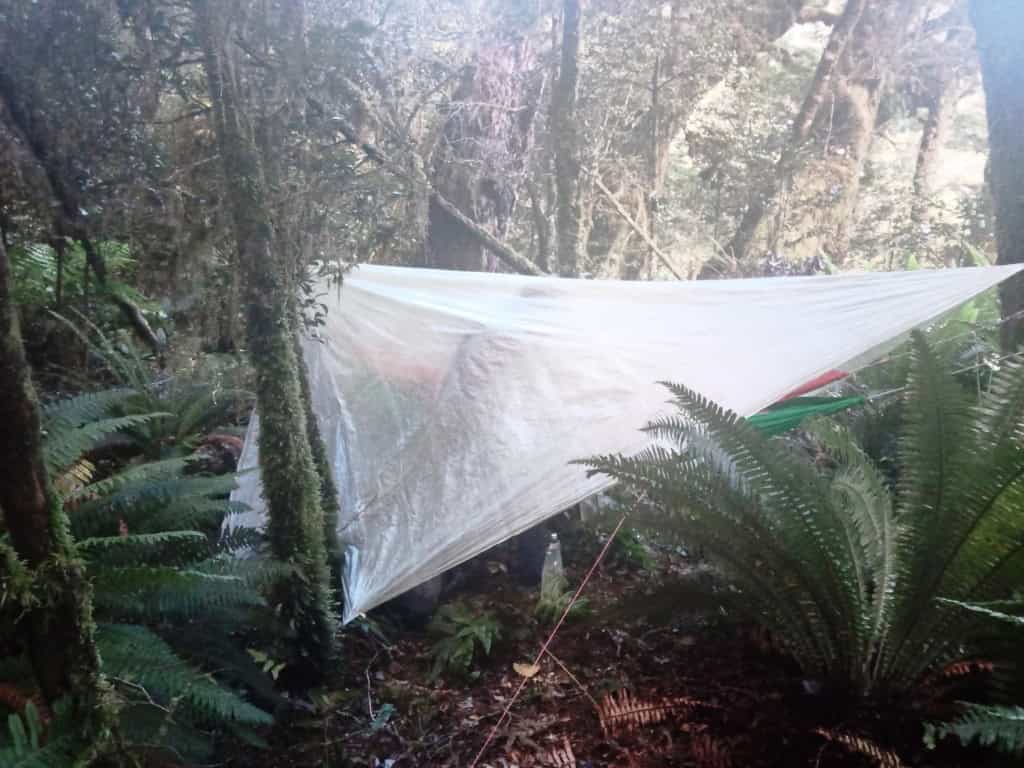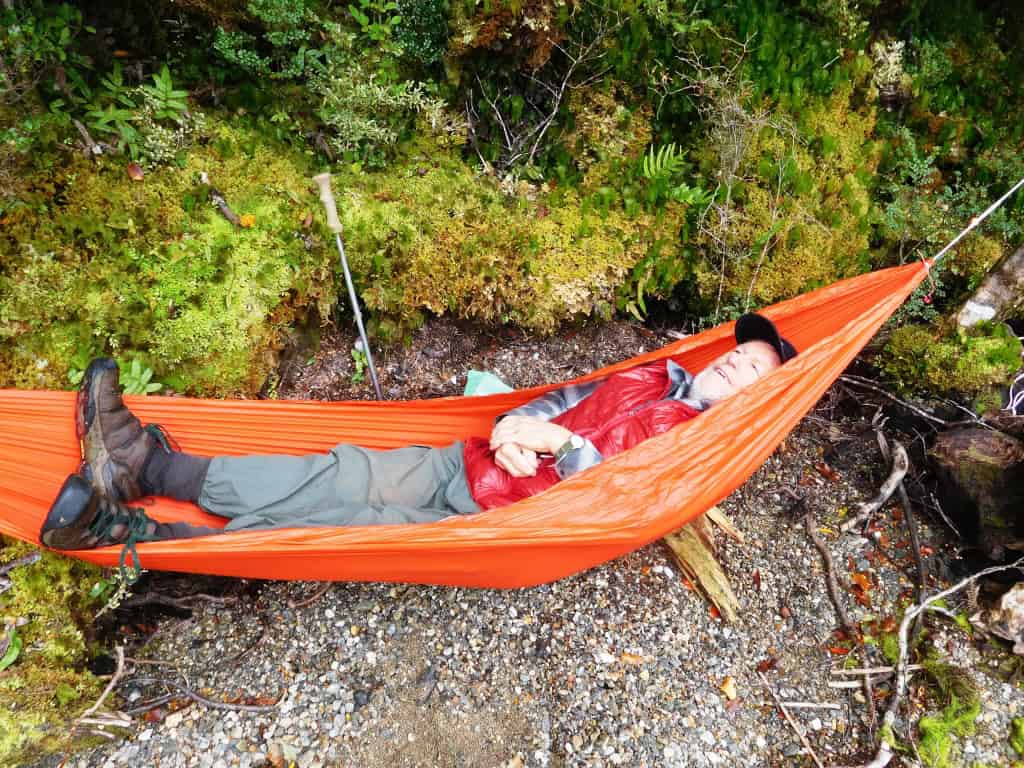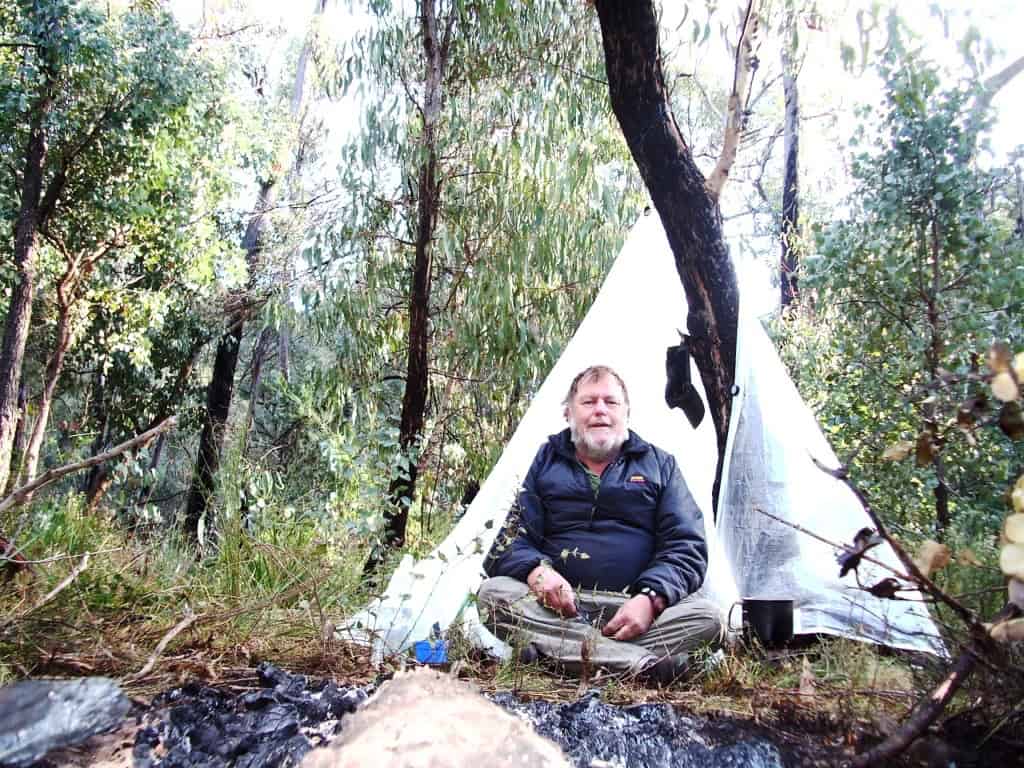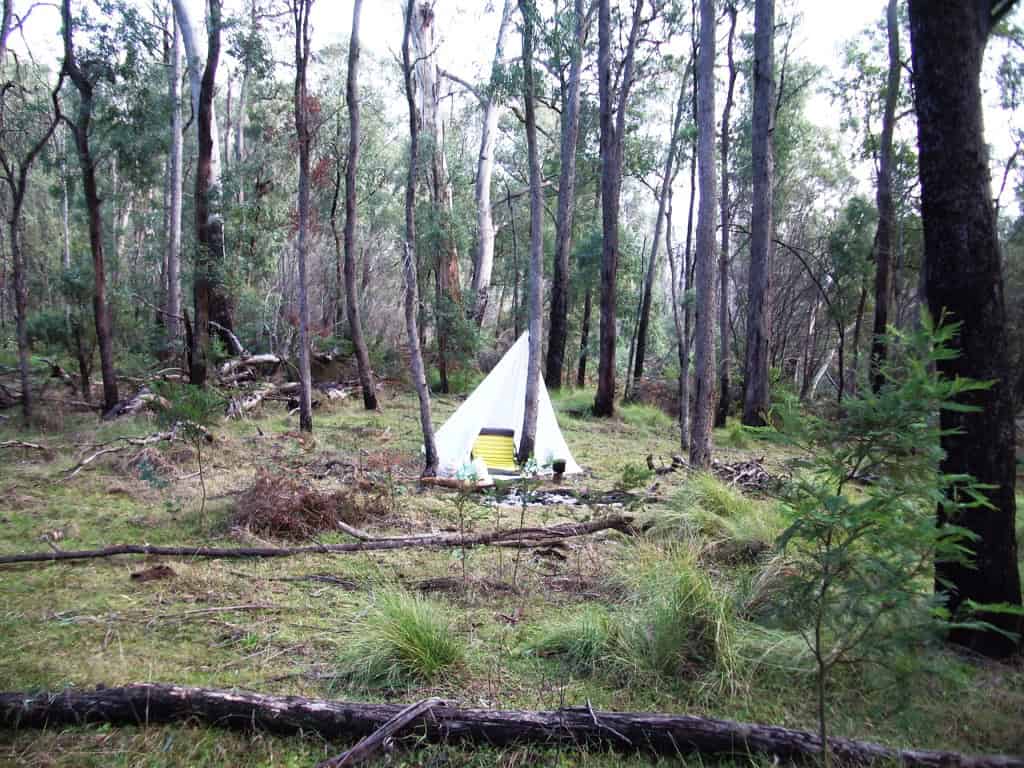I can’t imagine just how much ink and energy has been wasted on the conundrum, ‘What’s best as a camping option a tent or a hammock’ (plus fly)? But you can indeed have the best of both worlds – as the saying goes. You can carry a tarp which can be used either for sleeping on the ground or sheltering in your hammock as you take to the trees to avoid rough ground or too much water – as I have had to do many times. One of the reasons I am still alive really. A word to the wise: I have encountered people who are not because they could not.
A suitable hammock including suspension needs weigh no more than around 200 grams and neither does an 8′ x 8′ tarp (around the minimum size) – all you need to keep you perfectly sheltered in either situation. Of course you also may want an Ultralight Groundsheet for when you are on the ground but that does not need to add any more than maybe 50 grams unless you want something more durable. An adjustable ridgeline for the hammock (and if you like perhaps a second one to keep the tarp more perfectly pitched), and a little more lightweight string to stretch the fly plus a few guys, tensioners and pegs pretty much completes the arrangement. Still normally some change out of 500 grams – or not much more than a pound!
Two Hummingbird Hammocks swinging under my 150 gram 8 x8 Cuben Tarp Hiroko Burn Fiordland 2023:

Probably the lightest feasible hammock material weighs around .71oz per square yard (eg the Cloud 71 at US8.56 per yard from Dutchware) which will make a hammock for a 200lb person. You will need approximately three yards (US$25.68). If you are a bit heavier (or want a margin of safety/durability) you might choose the Hexon 1.2 (oz/yd2) fabric (at US6.96/yd) which will support a 275lb person – though if I was that heavy I doubt I would be walking very far!
A hammock needs to be (at least) 2′ (.6 metres) longer than you are. A little more will allow it to hang flatter. Of course if it is too long the tarp will need to be even longer. Three yards will make a hammock which is over 8.5′ long (allowing for a double hem at each end). Clearly the hammock body in the .71oz fabric (at that length) will weigh 1o2 grams and in the Hexon 1.2 oz it will weigh 170 grams.
Suspension: – You can tie straight to the tree with about 3.6 metres of Amsteel at each end – total 38 grams – which I still sometimes do, but you need to know how to tie the knot so it can be untied. Some sticks can be used to protect the tree). Anyway you will need (either to make or buy) two Continuous Loops (or similar) for the hammock ends from 7/64 Amsteel Blue (320 lb breaking strain) = 2.83 grams each and US$ 3.15 ea, two Whoopie Slings – the lightest method of adjusting the hang at 21 grams and US8.40 ea and two tree straps to protect the tree – the lightest material being the Spider Web 1.5 (grams per foot) straps at 18 grams and US$23.63 ea. I would make my own straps. 5′ is enough, buying the strap material and sewing them myself – which will save you a packet. 3/4″ Polyester Webbing at around 4.5 grams per foot) is good enough and you can buy enough for two hammocks for US$9.36.
As you can’t just daisy-chain them all together with larkshead knots you will need some kind of ‘toggle’ eg these Titanium ones at US5.46 the pair or a couple of carbon fibre tent stakes (a branch will do) as a joiner. This is the type of hammock suspension most people use and can weigh as little as 3 ounces altogether. Here is an excellent description of it.
I would probably recommend going with the Hexon 1.2 (170 grams + US20.88 ) plus the two continuous loops (5.66 grams = US$6.30), the two whoopie slings (42 grams and US$16.80) and the tree strap material 10′ is 15 grams and US$16.05. All you need to sew is the hammock and the two straps (232.66 grams & US$60.03). A big saving over buying a complete (high end) hammock set-up.
For comparison Dutch’s Chameleon hammock starts at US$120 (body only). Simply Designs can save you some money at least if you are in the USA but freight really kills American manufacturers if you need gear sent anywhere else in the world. There is obviously some kind of freight scam working in favour of Chinese manufacturers which is pretty much killing everyone else in the world. For example, His Voyageur starts at US$55 (body only) and comes with an innovative type of end which he claims ensures a flatter lay. Check it out. I would buy one just to see except for the freight. I don’t need a new hammock. NB He also has an ultralight hammock set-up The Wind Rider UL (complete inc suspension) for US$100 which weighs as little as 6.45 oz (184 grams)! Suitable for (careful) folks under 200 lbs. He also makes custom tarps.
PS: Dutch ships by First Class Mail® International which (for small items) is ‘reasonably’ affordable.
BTW: You can easily make your own fixed ridgeline (it should be 83% of the hammock length with a length of eg Amsteel Blue or similar.
Tier Gear here in Oz used to make many excellent hammocks, tarps and quilts and had many DIY supplies (some still available). They also (sadly) appear to have fallen victim to the Chinese. You may still pick up some DIY supplies but if you search for them on the Wayback Machine you will find that Simon once posted many useful DIY instructables eg about hammock and tarp making, such as DIY Netless Hammock and this DIY Tarp.
If you are in Oz you might consider the Grand Trunk Nano 7 which weighs around 200 grams and A$109 (add suspension). I have been using one of these (with a couple of lengths of dyneema cord as suspension) for years though it was superseded by my Hummingbird Hammock (now alas unavailable) which weighs 224 grams complete with suspension. Pack Light (above) also sell hammock suspension systems, etc. Whoopie Slings are available in Oz from Survival Supplies for A$35.84.
Relaxing in my 224 gram Hummingbird Hammock Supper Cove Fiordland 2017:

In conclusion you need to add roughly between 40 and 100 grams to the hammock fabric weight for your hammock suspension. The lightest hammock (plus cord) will therefore weigh just a bit over 140 grams.
However you can buy this Naturehike 265 gram hammock complete (with suspension) set-up from Aliexpress for A$67 delivered which is hard to beat. I own a fair bit of Naturehike gear and cannot fault it. Who can compete with the Chinese? Here is an Aricxi Tarp to go with it (at 450 grams though) for A$42.79 plus delivery (A$15.49) . This should be big enough to shelter two people (on the ground or in the air).
Tip: Instead of using the ‘toggles’ to join the hammocks to the whoopies, use a length of bush pole (approx 19mm and 45-60cm long). This will keep the two hammocks sufficiently separated that they will both hang (from the same two trees) under the one tarp.
The 8’x8′ tarp will be 11’4″ long (on the diagonal) allowing plenty of overhang of your (<9′ long) hammock. I would make it out of something like the Xenon Sil at .93oz/square yard and US7.76 per yard. You could use less (with more joins) but otherwise you are going to need 5 yards (US$38.80). A few scraps of something a little heavier for the four corners won’t go astray. Samples of an approx 2 oz/yd2 Robic would be good.
My 8 x 8 cuben tarp pitched as a ground shelter, Wonnangatta River 2011:

Ditto:

Obviously you need to sew it out of 2-3 pieces of material and will need to allow extra for the seams and at least another 1″ (each side) for a (double) hem so that the finished item is 8′ x 8′ (ie 2.4 x 2.4 metres). There is a choice of joining hems available including eg the famous flat-felled seam & etc You will need to seam seal the join.
As I said before I would reinforce the tie-outs with a patch of (preferably) slightly stronger material. I have found that if you sew this on first it is then doubled when you (single) hem) giving a much stronger anchor point. I usually just use 1 cm or 1/2″ gross grain ribbon for my tie-outs but you could use a stronger 1/2″ webbing for the four main ones if you want. You will want tie-outs half way along two of the sides for when your tarp is pegged to the ground. You will have realised that 8′ x 8′ is 64 square feet or 7.11 square yards which in the .93 oz/yd2 material will be 6.6 oz or 188 grams. Obviously the hems and tie-out will add a bit, (likewise some cord and cord locks) but you see where I get my estimate of 200 grams for this multi-purpose tarp.
A square tarp is simplest for this exercise but you should realise that I have been working on a better design (exemplified eg by my prototype Grey Flyer Tent/Tarp) which I will be posting a pattern for in the near future. In its final version I anticipate it will weigh a tad over 400 grams complete with bathtub floor and pegs. I am very busy building/renovating an old house for my daughter at the moment which will take up much of my time for the next few months.
There used to be a few 8′ x 8′ tarps available but the supply seems to have shrunk somewhat. Perhaps you will still find a ready-made one. There are any number of cheap square tarps (usually bigger) on Aliexpress and Amazon (some under $20) but they often blow out to more than twice this weight. Of course it would be a simple enough matter to cut one down to a smaller size – if you have the rudiments of sewing.
However consider this Aricxi diamond tarp (500 grams) for A$17.63 (inc delivery) or this Aricxi hex tarp (600 grams) for A$27.21 inc delivery) A little bit heavier perhaps but you can’t even buy the materials for that. I will buy one and let you know how it goes.
So we are talking a complete hammock + suspension + (8 x8) diamond tarp complete (delivered) for A84.63.
PS: How to tie your hammock to a tree: You go around the trunk then around the cord, around the trunk and around the cord again. 2-3 times doing this and the cord will no longer slip or tighten when you finish it off with a simple bow which can be undone by pulling on one end. This really does work. If you want to protect the tree you can place a few sticks between the cord and the tree on the outside edge. Many Australian trees are so hard-barked that they suffer very little damage from the cord anyway.
PS: I simply use my inflatable pad eg Thermarest X-Lite in my hammock to insulate my back. I have done this in temperatures down to -10C for many years without any problems. I find it quite comfortable. I will sew a couple of small webbing ‘tubes’ to the two (head-end) sides of he hammock (about 14″ in) so that I can use a stick inserted in them to hold the sides of the hammock sufficiently apart so that the hammock body does not compress my quilt where my elbows overlap my pad. Like this.

i think we could go even lighter by not bringing a separate backpack, using the tarp as a backpack. if we put two shoulder straps on the tarp at the right position it’s possible to
1 fold the tarp in half
2 fold the corner back in a triangle shape
3 pack stuff on the 2nd ~1:5 area of the tarp in between the layers
4 fold the triangle back
5 roll up the pack in a way that the pre-installed backpack straps land at the right place for carry
6 use a piece of cord to secure the top
this could save maybe 100 grams if we already carry a backpack (my 20+ litre pack is 99 grams, 10 € from decathlon, discontinued), but maybe not that practical for every day, unless we put some pockets on the tarp/pack somewhere.
it’s a very old idea with a modern twist because of the light waterproof materials. did you ever experiment with such an idea?
You should read this post: https://www.theultralighthiker.com/2017/08/07/humping-your-bluey/